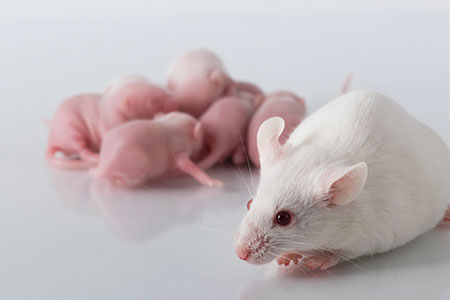 Exposure to stressful situations is difficult to avoid in the life of the laboratory mouse, but study design rarely accounts for the phenotypic effects of stress and the microbiome.
Exposure to stressful situations is difficult to avoid in the life of the laboratory mouse, but study design rarely accounts for the phenotypic effects of stress and the microbiome. Inevitable events and procedures, such as transportation, handling, and restraint, are known to induce stress in mice. Usually the stress response is transient and stabilizes within a period of time. The time until stabilization depends upon many things, such as:
- The length and severity of the stressor;
- The mouse strain and sex;
- Previous life experiences.
Events of much shorter duration, such as restraint and oral gavage, are also known to induce stress. Despite being brief, these procedures have the potential to confound study parameters if not considered in the study design. Simple measures, such as dipping the gavage needle in sucrose2, moving and handling of the mice by hand cupping of with a tunnel instead of tail-picking3,4, and habituation to restraint5 can reduce the stress response, creating less experimental variation and bias while improving animal welfare.
Linking Microbiota Composition and Stress
The microbiome is sensitive to stress, and stress-induced microbiome alterations change both the physiology and behavior of the host. For example, stressing mice by grid floor housing causes altered microbiota composition, which in turn influences performance in behavioral tests6. Repeated exposure to an aggressive conspecific also causes altered microbiota composition and induces proinflammatory cytokines systemically7.A recent study used fecal microbiota transplantation to prove that impact on the phenotype as a consequence of stress was indeed mediated via the microbiome. The authors transferred the microbiota from mice exposed to a chronic restraint stressor to germ-free mice. The recipients displayed increased proinflammatory response and worsened colonic pathology compared to germ-free mice receiving the microbiota from unstressed mice8.
Impacts of Short-Term Stress
Most examples from the literature describe effects of prolonged or chronic stress on the microbiome. However a relatively short stressor (one two-hour social disruption stressor) is also reported to alter a mouse's microbiota profile, in particular the relative abundance of Lactobacilli9.Only very recently has it been investigated if oral administration, which is a much more transient stressor, has potential to change the microbiome of mice10.
This question is particularly relevant for studies of probiotic bacterial species known to be sensitive to host stress, which is the case for example for Bifidobacterium longum subspecies infantis. Allen-Blevins et al. therefore evaluated different techniques for oral administration to mice, hypothesizing that mice subjected to the least stressful technique would have the highest number of Bifidobacteria in the gut.
The authors tested two non-gavage oral administration techniques: An active administration by instilling a micropipette tip in the mouth of the mouse pups and injecting the dosage into the oral cavity, and a passive administration by transferring the dosage to Creamatocrit tubes (small glass tubes used for measuring lipid content of breast milk) or micropipette tips and letting the pups suck the solution from the tube or the pipette tip.
The authors did not find any changes in gastrointestinal or fecal microbiota between the treatment groups, indicating either that both techniques elicited a similar stress response, or that the response was not enough to change the microbiota.
They also compared the two treatment groups to non-handled control pups — and in this case the authors found significant fewer Bifidobacteria, Bacteroides, and Bacteroidetes in the handled versus the non-handled pups. Allen-Blevins et al. conclude that handling and restraint alone, even without gavage, may induce enough stress to alter mouse microbiota, in this case loss of specific bacteria.
Accounting for Stress and the Microbiome
The microbiome is highly responsive to stimuli from the environment and the host. The mouse microbiome is affected by virtually all thinkable husbandry factors, so it is not unlikely that experimental factors, such as restraint, can affect the microbiome as well. If so, consideration of the stress effect of handling and experimental procedures in mouse microbiota studies is important. Prolonged preconditioning/habituation to the intended experimental procedures may be necessary for stabilizing stress-induced microbiota alterations.However, several caveats must be observed in this context. Studies linking stress to microbiome are sensitive to a variety of confounding factors.
Is the Baseline Microbiota Accounted For?
In the cited study by Allen-Blevins et al., it is not disclosed whether the non-handled pups had the same baseline microbiome as the handled pups, and it is not clear whether these control mice originated from the same vendor source as the treatment mice. Failing to account for an effect of the baseline microbiota may lead to misinterpretation of results, and disclosure of such information is therefore crucial in published reports.Are All Environmental Variables Accounted For?
In behavioral studies where mice are moved from their home cage to test systems in other rooms, changes in the microbiome may happen due to change in environment, but may be interpreted differently. The microbiological status of the procedure room may be different than in the home cage room and different personnel may be handling the mice when they are in the home cage versus in the procedure room.Studies exploiting social stressor regimens where aggressive mice are co-housed with docile mice for a defined stressor period, should likewise consider (and disclose) whether observed microbiome alterations are likely to happen solely in response to stress, or if co-housing itself can have an affect due to different microbiological statuses of the mice.
Interactions between host stress and the microbiome need to be described and controlled for by carefully experimental design and baseline microbiota measurements. Further investigation is required to explore the impact of brief stressors on the microbiome, such as restraint for oral administration, and if that change is persistent or temporary.
















.jpg)

.jpg)
.jpg)
.jpg)
.jpg)





.jpg)


.jpg)
.jpg)




.jpg)




.jpg)

.jpg)




